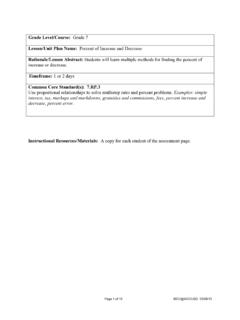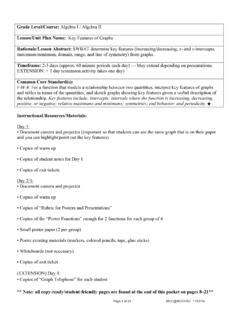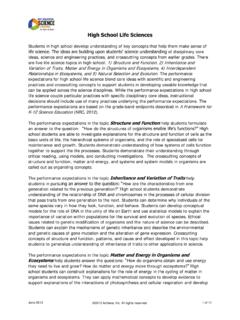Transcription of Lesson/Unit Plan Name: Key Features of Graphs SWBAT ...
1 Page 1 of 23 MCC@WCCUSD 11/07/14 Grade Level/Course: Algebra I / Algebra II Lesson/Unit Plan Name: Key Features of Graphs Rationale/Lesson Abstract: SWBAT determine key Features (increasing/decreasing, x- and y-intercepts, maximum/minimum, domain, range, and line of symmetry) from Graphs . Timeframe: 2-3 days (approx. 60 minute periods each day) May extend depending on presentations. EXTENSION: + 1 day (extension activity takes one day) common core Standard(s): : For a function that models a relationship between two quantities, interpret key Features of Graphs and tables in terms of the quantities, and sketch Graphs showing key Features given a verbal description of the relationship. Key Features include: intercepts; intervals where the function is increasing, decreasing, positive, or negative; relative maximums and minimums; symmetries; end behavior; and periodicity.
2 Instructional Resources/Materials: Day 1: Document camera and projector (important so that students can see the same graph that is on their paper and you can highlight/point out the key Features ) Copies of warm up Copies of student notes for Day 1 Copies of exit tickets Day 2/3: Document camera and projector Copies of warm up Copies of Rubric for Posters and Presentations Copies of the Poster Functions enough for 2 functions for each group of 4 Small poster paper (2 per group) Poster creating materials (markers, colored pencils, tape, glue sticks) Whiteboards (not necessary) Copies of exit ticket (EXTENSION) Day 4: Copies of Graph Telephone for each student ** Note: all copy-ready/student-friendly pages are found at the end of this packet on pages 8 21** Page 2 of 23 MCC@WCCUSD 11/07/14 DAY 1 Warm-up (5 minutes): Give students a half sheet with the vocabulary brainstorm on it (Note: all copy-ready notes are found at the end of this lesson).
3 List the following vocabulary words on the board and instruct students to choose 2 of the words and take 3 minutes to write down everything they know about the word, draw a picture, and try to come up with a definition. x-intercept y-intercept maximum minimum symmetry domain range Spend 2 minutes debriefing the warm-up by asking students to raise their hand and give you some information about each of these words. Write down as much relevant information as you can next to the word on the board. Student Notes: Day 1 Vocabulary (10 minutes): If this is review for your students, ask them to help give you the definitions by either raising their hands or using equity sticks. Domain: the input or x-values Range: the output or y-values Define the x- and y-intercepts for students and label those points on the graph to the right.
4 X-intercept: where the graph of the function crosses the x-axis y-intercept: where the graph of the function crosses the y-axis Define maximum and minimum for students and label those on the graph. The maximum of a function is the largest function value (output/range) The minimum of a function is the smallest function value (output/range) x-intercepts y-intercept The minimum occurs at x = 4. OR The minimum value of f is 3. The maximum occurs at x = 2. OR The maximum value of f is 6. Page 3 of 23 MCC@WCCUSD 11/07/14 Define increasing and decreasing for students and highlight the parts of the graph where each is happening. Increasing: going up (when read from left to right) Decreasing: going down (when read from left to right) Define axis of symmetry for students and guide them through labeling the axis of symmetry (if one exists) for the figures below the definition.
5 Axis of symmetry: a line through a shape so that each side is a mirror image No axis of symmetry. I DO (5 minutes): 1. Find the key Features of the function f(x), graphed here. a) Is the graph increasing or decreasing from x = 2 to x = 0? Highlight the part of the graph that we are talking about, the section between x = 2 and x = 0. Say If I look at the section of the graph in question, and I look from left to right, I see that the graph is sloping down. Therefore, on this interval, the graph is decreasing. b) Is the graph increasing or decreasing from 2 < x < 3? Highlight the part of the graph that we are talking about, the section between x = 2 and x = 3. Say If I look at this section of the graph from left to right, I see that the graph is sloping up.
6 Therefore, on this interval, the graph is increasing. c) x-intercept: Remind students that the x-intercept is where the graph crosses the x-axis. Follow the x-axis with your finger until the graph crosses it. This happens in two places x = 1 and x = 2. Also, write these as the points ( 1, 0) and (2, 0). is where the graph is increasing. is where the graph is decreasing. Page 4 of 23 MCC@WCCUSD 11/07/14 d) y-intercept: Remind students that the y-intercept is where the graph crosses the y-axis. Follow the y-axis with your finger until the graph crosses it. This happens once, at y = 2. Also, write as a point (0, 2). e) Evaluate f(1) = Say We are trying to find f of 1. This means where the graph is (or the y-value of the graph) when x = 1.
7 Find x = 1 with your finger and follow it down to meet the graph. Say This is the point (1, 2). When x = 1, the function is at 2. Therefore, f of 1 is negative 2. f) Maximum: Remind students that a maximum is the largest value of the function, or the largest range value. Looking at this graph, it has arrows at the top, which means the graph extends to positive infinity. Therefore, this function does not have a maximum. g) Minimum: Remind students that a minimum is the smallest value of the function, or the smallest range value. Looking at this graph, and tracing it with my finger, I can see that the lowest it will get is when y is a little smaller than 2. I can estimate this minimum value as and say that f(x) has a minimum of and that minimum occurs at x h) Domain: The domain is all the possible x-values for this function.
8 I start on the left and look towards the right. Because of the arrows on the left side of this graph, I know that it will extend towards the left until negative infinity. The graph is continuous through until the arrow on the right. This means that it will extend towards the right until positive infinity. The domain can be represented by ( , ) or <x< . i) Range: The range is all the possible y-values for this function. I start at the bottom and look upward. The graph does not begin until its minimum at y The graph is continuous through until the arrows on the top. This means that it will extend upward until positive infinity. The range can be represented by [ , ) or x< . j) Axis of symmetry? There is an axis of symmetry for this function.]
9 It passes through the graph at its minimum. It can be approximated by the line x = (It is enough at this point for students simply to draw the axis of symmetry.) Page 5 of 23 MCC@WCCUSD 11/07/14 WE DO (10 minutes): For problem #2, guide students through finding all of the key Features using equity sticks. Ask questions like: What are we looking for here? How can we tell if a graph is increasing? Name one interval where the graph is increasing. Is there another? Name that interval in another way. Emphasize set notation ( , 7] vs. inequalities < y 7 Where can we find the y-intercept? Does this function have a y-intercept? How do you know? Where is it? Can you write that as a point?)
10 Why or why not? What is the point? ..etc. For problem #3, have students work on this in pairs or groups then use equity sticks to call on someone to share what they thought about each part (a e) of the question. If there is confusion, ask students to come up to the document camera to point out the parts of the graph in question. WE DO Solutions: 2. Find the key Features of the function g(x) . a) Where is the graph increasing? The graph is never increasing. b) y-intercept: y = 6 or (0, 6) c) x-intercept: x = 2 or ( 2, 0) d) Find g(3) = 1 e) Maximum: Appears that g(x) has a maximum value of 2. f) Minimum: There is no minimum on this graph. g) Domain: ( , ) or < x < h) Range: ( , 2) or < y < 2 i) Axis of symmetry?
















